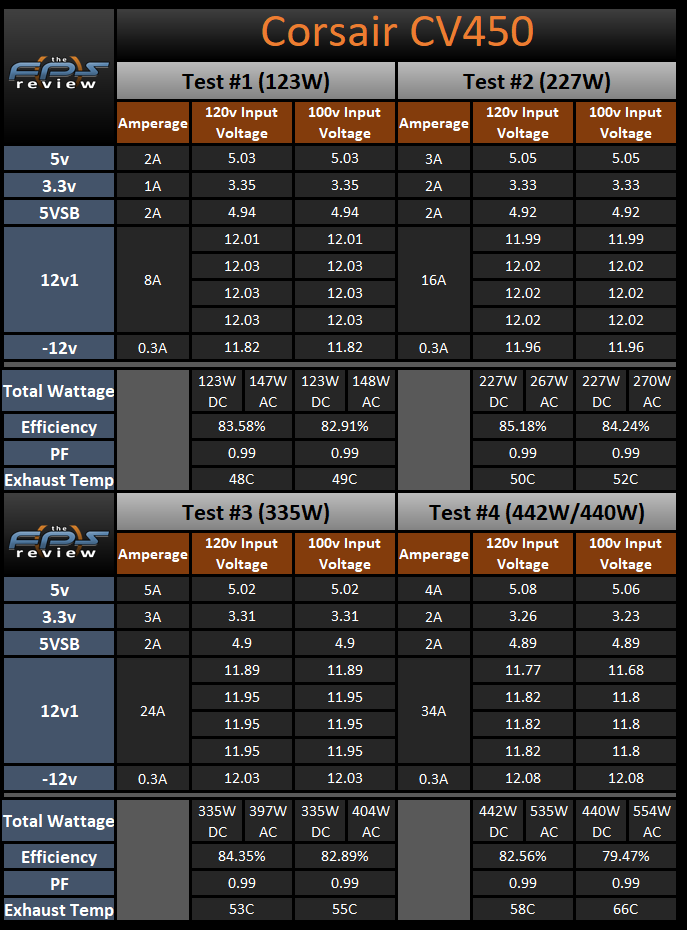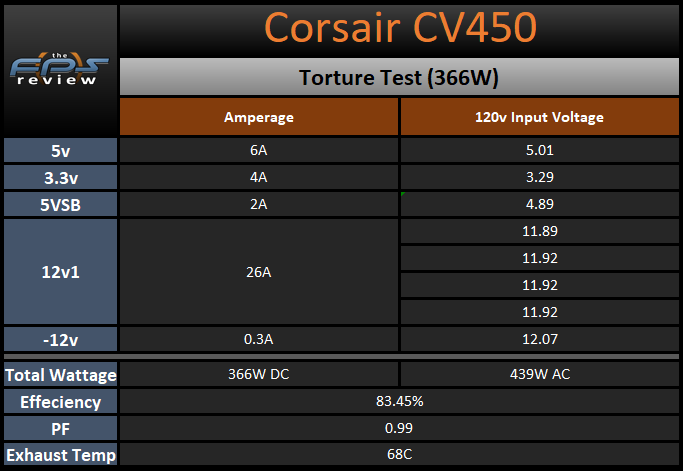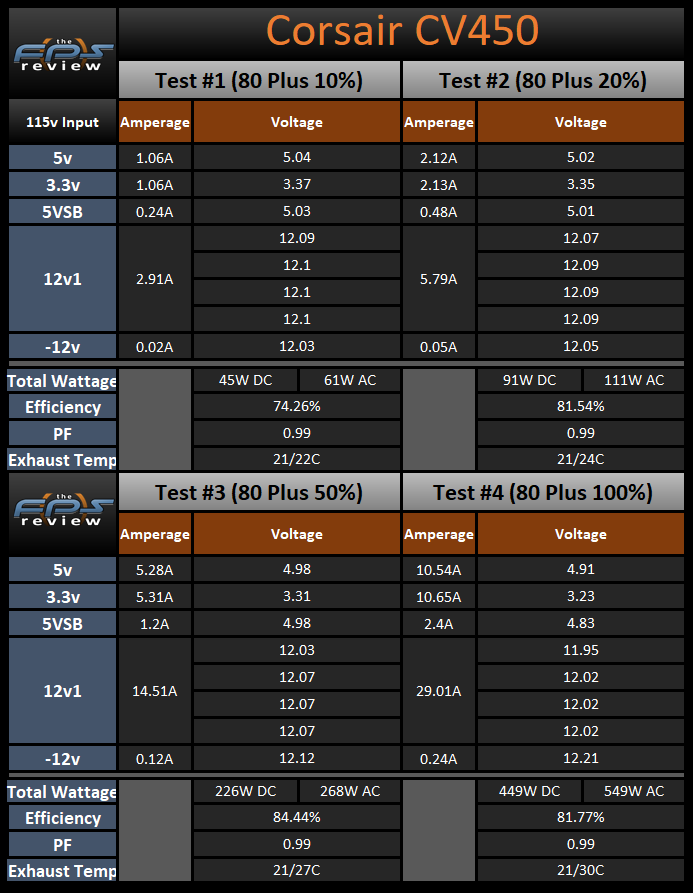Load Testing
For those of you that are curious as to some of the reasoning and equipment behind our PSU testing program here at TheFPSReview, we have put together an introduction for you. This program is based on what the author developed at [H]ardOCP and utilizes the equipment bequeathed to the author by Kyle Bennett. The testing we are conducting today is exactly as described in that document and start with our 120v, 100v, Torture, and 80 Plus Tests.
120v and 100v Load Testing Results

Test #1 is equal to approximately 25% of the rated capacity of the Corsair CV450 at 45c. This makes Test #1 equal to 123W by loading the 12v rail to 8a, the 5v rail to 2a, the 3.3v rail to 1a, the +5vsb to 2a, and the -12v to 0.3a. The results of Test #1 show the main positive DC output rails starting above nominal except for the 5v rail. The efficiency for this unit is starting off in decent shape at a value of 83.58% at 120v AC input and 82.91% at 100v AC input. We see the exhaust temperature is 48C at 120v AC input and 49C at 100V AC input.
Test #2 is equal to approximately 50% of the rated capacity of the Corsair CV450 at 45c. This makes Test #2 equal to 227W by loading the 12v rail to 16a, the 5v rail to 3a, the 3.3v rail to 2a, the +5vsb to 2a, and the -12v to 0.3a. Test #2 sees all of the DC output voltages drop relative to what we saw with Test #1. The largest changes are a 0.02v decrease on the 5v and 3.3v rails followed by an up to 0.02v drop on the 12v rail. The efficiency has moved up to 85.18% at 120v AC input and 84.24% at 100v AC input. We see an exhaust temperature of 50C at 120v AC input and 52C at 100V AC input.
Test #3 is equal to approximately 75% of the rated capacity of Corsair CV450 at 45c. This makes Test #3 equal to 335W by loading the 12v rail to 24a, the 5v rail to 5a, the 3.3v rail to 3a, the +5vsb to 2a, and the -12v to 0.3a. Test #3 sees the 12v, 5v, and 3.3v rails drop by varying amounts. The 12v rail drops the most with a peak change of up to 0.1v while the 5v rail drops by 0.03v and the 3.3v rail drops by 0.02v. The efficiency in Test #3 moves down to 84.35% at 120v AC input and 82.89% at 100v AC input. We see an exhaust temperature of 53C at 120v AC input and 55C at 100V AC input.
Test #4 is equal to approximately 100% of the rated capacity of the Corsair CV450 at 45c. This makes Test #4 equal to 442W/440W by loading the 12v rail to 34a, the 5v rail to 4a, the 3.3v rail to 2a, the +5vsb to 2a, and the -12v to 0.3a. In the final regular test, we see the 12v rail drop by up to 0.23v! The 5v rail, however, recovers a bit and moves up to 0.06v. The 3.3v rail drops by up to 0.08v. The efficiency has dropped as we see it come in at 82.56% at 120v AC input and 79.47% at 100v AC input. We see an exhaust temperature of 58C at 120v AC input and 66C at 100V AC input.
Torture Test

The Torture Test is equal to approximately 80% of the rated capacity of the Corsair CV450 at 45C full load. This makes the Torture Test equal to 366W by loading the 12v rail to 26a, the 5v rail to 6a, the 3.3v rail to 4a, the +5vsb to 6a, and the -12v to 0.3a. At the end of the Torture Test, the CV450 was still running. The DC output voltages are generally in line with what we have been seeing in the 120v load tests but the unit is laboring. The efficiency is ok as we see a value of 83.45% and the exhaust temperature is 68C.
80 Plus Load Testing Results

As we see here, the Corsair CV450 posts efficiency values of 81.54%-84.44%-81.77% using 80 Plus’ load testing parameters. This means this unit fails to meet the 80 Plus Bronze standards at every load tested. However, we do use different equipment than 80 Plus for our testing and there is always a bit of component variation.
Load Testing Summary
The Corsair CV450 passed our load testing today (which is one of the most surprising things we have seen to date). From the get go, it looked like there was no way this unit should pass. However, just because it did pass does not mean it did a good job, just that it passed. When we look at the voltage regulation, we see that the CV450 had peak changes of 0.33v on the 12v rail, 0.06v on the 5v rail, and 0.12v on the 3.3v rail. These absolute values are in the specification but not good overall (especially the 12v rail and 3.3v rail).
When we look at the efficiency values posted today, we see that the CV450 ranged from 82.56% to 85.18% efficient at 120v AC input and 79.47% to 84.24% efficient at 100v AC input. On the 80 Plus tests, this unit saw efficiency values of 81.54%-84.44%-81.77%. So, not only were the efficiency values low in general, this unit also missed its claimed 80 Plus Bronze efficiency levels (which is not exactly a high bar these days). Lastly, the exhaust temperatures got kind of toasty as this unit peaked at 58C at 120v AC input, 66C at 100v AC input, and 68C during the Torture Test. With passing starting results in today’s testing, let’s move on to the Transient Load Tests.
